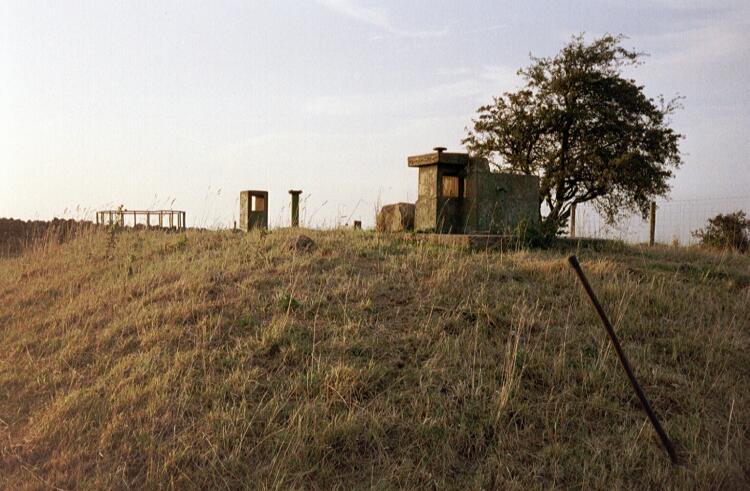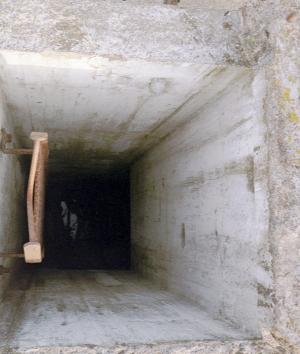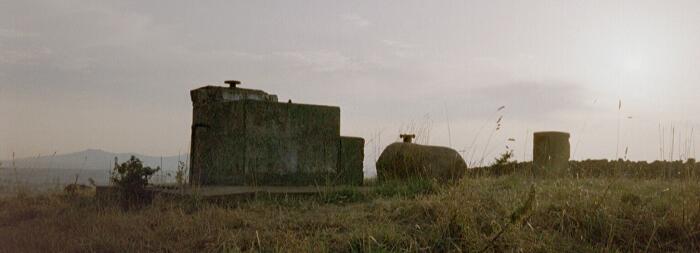

 The Royal Observer Corps first came to this site in August 1954, going underground, in the bunker seen here, in October 1965. The change to underground accommodation reflected the change of role for the ROC from aircraft spotters to nuclear fallout monitors (The United Kingdom Warning and Monitoring Organisation). There has been a ROC presence in the Armathwaite parish since October 1939, however, when a post was constructed in the early days of WWII at a site just above the village school, about three miles away. There are no traces remaining of this earlier post.
The Royal Observer Corps first came to this site in August 1954, going underground, in the bunker seen here, in October 1965. The change to underground accommodation reflected the change of role for the ROC from aircraft spotters to nuclear fallout monitors (The United Kingdom Warning and Monitoring Organisation). There has been a ROC presence in the Armathwaite parish since October 1939, however, when a post was constructed in the early days of WWII at a site just above the village school, about three miles away. There are no traces remaining of this earlier post.
The remains of this post are in pretty good shape, considering it was closed in October 1968, its paltry three-year existence a result of the Wilson Government Civil Defence cutbacks. 686 other posts were to meet a similar fate - including a neighbouring post at Greystoke - leaving only 873 posts to undertake their vital function until the ROC was stood down in March 1992.
The UKWMO posts similar to the one described on this page were spread the nation over at intervals of roughly 14 miles. Following the 1968 Civil Defence cuts, any hint of nuclear armageddon despoiling the Eden Valley would be monitored by the adjacent posts at Penrith, Hesket-Newmarket, Dalston, Carlisle, Brampton, Alston and Culgaith, and reported to Group HQ at Carlisle.
The above images are linked to larger versions showing the 15' x 7'6" bunker layout fifteen feet below the surface, equipped to be capable of sustaining a four-person crew for one week. The picture on the left shows the instrument table still in position, and a slight discoloration of the end wall where the bunks were. One of the air-vents is visible at the top of the photograph. An outline on the lower wall next to the instrument table betrays the position of a small cupboard
The centre picture shows the way out to the entrance chamber (yes, there are toilet facilities - a small room on the right, at the bottom of the ladder contained an 'Elsan' chemical closet. It is still there!). The timer-switch for the battery-powered 12 Volt lamp is still attached to the wall. The battery was located on the floor to the right of this doorway and was charged outside using a small petrol-driven generator, provided at a cost of either £45 or £52 (there were two models) to each post. Fuel for the generator was sometimes buried in soft earth outside the post. Also visible at the bottom of the ladder is a small pipe. This would have been attached to a bilge-pump, to remove any water collected in the small sump at the base of the ladder shaft. The pump and remaining pipe have disappeared.
The GPO connection boxes, the 'shadow' where the notice board had been, and the remains of the 12 Volt lamp can be seen in the right-hand picture. Each post was provided with a 'carrier-warning receiver' - used to alert the post of the state of war, and a 'teletalk' two-way amplified speech instrument, the successor to a more primitive headset and breastplate microphone set.
 The outside of the bunker can be seen in greater detail in the photos on the left. The fat pipe protruding from the mound was to fit a 'Fixed Survey Meter' attachment, consisted of a radiation meter on the inside, and an ionisation chamber on the outside. This enabled the radioactivity to be monitored safely
The outside of the bunker can be seen in greater detail in the photos on the left. The fat pipe protruding from the mound was to fit a 'Fixed Survey Meter' attachment, consisted of a radiation meter on the inside, and an ionisation chamber on the outside. This enabled the radioactivity to be monitored safely
A means of determining the magnitude of the blast was connected to a thinner pipe, and was known as the BPI - or 'Bomb Power Indicator. An ominously entitled 'Ground-Zero' Indicator - consisting of a film cartridge with slotted apertures facing north, south east and west to record the nuclear explosion - was affixed to the entrance hatch block. This instrument was also known as a 'Shadograph', and the fireball would create an image on the film giving an indication to its direction. The information gathered by the Armathwaite post would be correlated with that recorded at other sites, giving a fix on where the bomb had gone off.  The top layer of the entrance has been removed from this post for some reason, but the mount for the GZI can still be seen. It consists of a small circular plate which is fixed on top of the air vent adjacent to the entrance shaft.
The top layer of the entrance has been removed from this post for some reason, but the mount for the GZI can still be seen. It consists of a small circular plate which is fixed on top of the air vent adjacent to the entrance shaft.
BELOW: The sun sets closing a calm September day as the monolithic remains of this once all-important harbinger of death and mayhem gently crumble to ruin, its duties no longer called for as events in the wider world ever change. Blencathra sits benignly in the background, casting an evening shadow over a similar post at Threlkeld, another of the 23 UKWMO sites which - not so long ago - might have alerted Cumberland to the unimaginable horror of nuclear war.

Home | Contents | Workington | Links | E-Mail